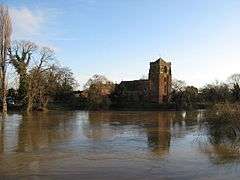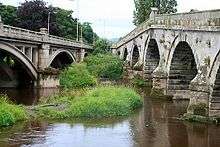Atcham
Atcham is a village, ecclesiastical parish and civil parish in Shropshire, England. It is situated on the B4380 (the old A5), 5 miles south east of Shrewsbury. The River Severn flows around the village. To the south is the village of Cross Houses, and to the north west the hamlet of Emstrey.
| Atcham | |
|---|---|
 River Severn in flood at Atcham | |
 Atcham Location within Shropshire | |
| Population | 243 (2001)[1] |
| OS grid reference | SJ542092 |
| Civil parish |
|
| Unitary authority | |
| Ceremonial county | |
| Region | |
| Country | England |
| Sovereign state | United Kingdom |
| Post town | SHREWSBURY |
| Postcode district | SY5 |
| Dialling code | 01743 |
| Police | West Mercia |
| Fire | Shropshire |
| Ambulance | West Midlands |
| UK Parliament | |
Local governance
It once belonged and gave its name to Atcham Rural District, before that was merged into the Borough of Shrewsbury in 1974, and the village came under Shrewsbury and Atcham Borough Council. From 2009, Shrewsbury and Atcham was merged with the other districts of non-metropolitan Shropshire to form Shropshire Council. The Parliamentary constituency which covers the borough remains as Shrewsbury and Atcham. In terms of population, Atcham is the smallest village represented in the name of a UK Parliamentary constituency.
History
The only church in England to be dedicated to Saint Eata, bishop of Hexham, can be found in the village. The reasoning behind the dedication is unclear. There is no written record suggesting that he ever came so far south. There is, however, a crop photograph from the 1970s of a field in Attingham Park showing the ground plan of a Saxon palace identical to one excavated near Hexham. "Atcham" is a contraction of "Attingham", meaning "the home of Eata's people". The church building dates back to the 11th century.
The local airfield RAF Atcham (now returned to agriculture and light industry) was home to an American training unit for much of World War II. It used P-47 Thunderbolts and later P-38 Lightnings for operational training of new fighter pilots posted in from the United States. Almost 50 pilots were lost in accidents flying from there.
The A5 London–Holyhead road once ran through the village, but now runs to the north on a new dual-carriageway.
Notable people
In order of birth:
- Ordericus Vitalis (1075 – c. 1142), chronicler and Benedictine monk, was baptised in the village.[2]
- Noel Hill, 1st Baron Berwick (1745–1789), politician and landowner, builder of Attingham Park, was buried in the village church.
- Anna Kingsford (1846–1888), first female English medical graduate and vegetarian, was buried in the village church.
- Digby Tatham-Warter (1917–1993), Second World War British Army officer famed for carrying an umbrella
- Dick Sale (1919–1987), first-class cricketer and school headmaster, was born in the village.
Features

Famous landmarks at Atcham include Attingham Park, seat of the Berwick barons until the title became extinct in 1953. The hall at Attingham Park is now the regional headquarters of the National Trust. Also on the estate is the Shropshire office of Natural England. Adjacent to Attingham Park is Home Farm Attingham. Home Farm, now separate from the hall that it traditionally would have supplied, is a family-run organic farm and tea room open to the public.
There are two bridges at Atcham, the older one, built in 1774, being commonly known as Atcham Bridge, while the newer one, which was opened in 1929, carries the Old A5 (B4380) road over the River Severn.[3]
Nearby, outside the parish to the east, is the village of Wroxeter, formerly a Roman city, and currently the site of one of Shropshire's commercial vineyards.

There is a public house in the village called the Mytton & Mermaid (owned at one time by Clough Williams-Ellis as a staging post on the way to his iconic Italianate village of Portmeirion), but the school, post office and petrol station have all closed. The former garage remains as a small car-sales and vehicle-repair business.
Atcham has a timber-framed village hall named the Malthouse, built in the 17th century as such, but after disuse converted in the 19th century into carpenter's shop for the Attingham estate. It was opened after restoration in 1925 as the village hall and dedicated to the memory of the men of Atcham who had died in World War I. It has a sprung floor bought from a dance hall in Shrewsbury.[4]
Nearby is Atcham Business Park/Industrial Estate, on the site of the old airfield. Despite its name, it lies in the neighbouring civil parish of Wroxeter and Uppington,[5] although after the Diocese of Lichfield made some boundary changes, it is now in the ecclesiastical parish of Atcham.
See also
References
- "Civil Parish population 2011". Retrieved 21 November 2015.
- ODNB Retrieved 27 March 2018.
- "Panoramic of Atcham Bridge". BBC Shropshire. Retrieved 26 April 2008.
- Francis, Peter (2013). Shropshire War Memorials, Sites of Remembrance. pp. 99–100. ISBN 978-1-909644-11-3.
External links
| Wikimedia Commons has media related to Atcham. |